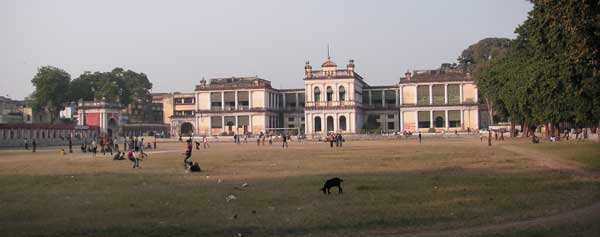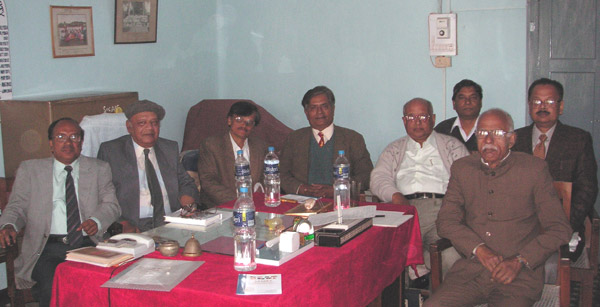SWEDISH SOUTH ASIAN STUDIES NETWORK
Staffan’s visit to Patna University, Friday 16 December 2005
 |
| University of Patna, the old Dutch Salpetre godown from the 17th Century. |
Web page:
puonline.bih.nic.in/
The university was started in 1916-17, but before that there was the
Patna College inaugurated in 1863 – one of the oldest colleges in
India.
Today this is the smallest university in Bihar with about 10 000 students
at four faculties, Arts, Social Sciences, Natural Sciences and Law.
Both undergraduate, graduate and post graduate programmes exist side by
side. A medical college is affiliated, but engineering is separate in
the National Institute of Engineering, Patna. There are about 1000 teaching
positions, but many of them are vacant, since after retirement of many
teachers the University has not employed new teachers.
The University is starved of funds and the state government interferes
in all what is happening here.
The university buildings, class rooms and offices are in a poor shape.
One feels like being in a dark cellar, when inside some of the premises.
According to my host, Prof. Jha the whole situation is depressing to the
teachers, who work without inspiration.
So the contrast is sharp between the hefty old buildings of the Dutch
saltpetre go-down built in the 17th century and the Maharaja’s palace,
which is now part of the university, and the newer buildings and their
inside facilities.
Visit to the Department of Sociology
 The
first meeting was in this department, which is a post-graduate department
with 4 teachers, 160 master students, and 10 PhD students. In the undergraduate
department, there about 500 students and ten teachers.
The
first meeting was in this department, which is a post-graduate department
with 4 teachers, 160 master students, and 10 PhD students. In the undergraduate
department, there about 500 students and ten teachers.
After my presentation of SASNET, we had an interesting discussion about their research interests and the situation in Bihar. Several of those present are pursuing studies of rural development and agrarian relations. Two were interested in gerontology, one in tribal studies, one in gender relations, one in demography, and finally one, the oldest member of the staff, in research methodology. We had an interesting discussion about the Bihar situation, and the following is their analysis.
The Bihar situation is paradoxical. Bihar was the granary of India during
the British period, with fertile soils, well developed irrigation system
and an efficient administration. The problems started in the 1960s with
the growing influence of caste on politics. ‘Nepotism took precedence
over qualifications’ in the appointment of government officers.
The administration is now so inefficient that it can only use 50 % of
the funds allocated by the Union government for development projects!
At the same time civil society is weak and dominated by the government
which wants to have a say in everything.
This is one reason why there has been de-industrialization of the state
and also de-peasantisation.
During the period 1995 – 2005 Bihar had an industrial growth of
– (minus) 57 %, while the whole of India saw industrial growth at
17 % plus. Bihar once had the biggest sugar- and paper mills in the country,
but now they are no more. When Jharkand in the South became a separate
state, Bihar lost most of the remaining industries, the Bokharo Steel
plant, mines, etc.
Through land reforms and fragmentation via inheritance, the landlords
have become small peasants and petty farmers. The Naxalites have mobilized
the agricultural labourers so that they demand very high wages. For the
small farmers this is impossible to pay, so they now use mostly family
labourers also women. But in the upper castes, women are not allowed to
work on the fields, so they are suffering from the high wage demand of
the labourers.
Today the only source of mobility is through education and government
employment. In reality very few government posts are opened per year,
so the real alternative is joining the army.
There is no strong Hindu fundamentalist movement in the state, and also
no sharp conflicts between Muslims and Hindus. When Nitish Kumar won the
recent elections in the state due to the support of the BJP, it was not
a question of rising Hindu feelings but rather an incumbency vote. Lalu
Prasad Yadav came to power representing the Yadav’s and other backward
castes. With him there was 15 years of misrule, robbing the people in
the name of the poor, speaking the language of the poor masses, etc. and
behaving after the saying of Lalu: ‘For remaining in power there
is no need for government.’
The whole rural infrastructure has deteriorated, irrigation systems have
not been maintained, roads are bad, there is not electric supply to the
villages, etc. When asked about it, Lalu used to answer: ‘If we
build roads and supply electricity, who do you think will use them?’
The green revolution has not at all reached here also because the state
administration was not interested in promoting it. At the same time, education
and health delivery is poor, so there is no family planning to speak of.
The population has risen fast and there are now 880 persons per sq km
vis-à-vis 320 for the whole of India.
Also Women’ Self-Help Groups have failed here. The Banks are not
interested to lend money to the women, and the government is not interested
in letting the women really participate in the scheme.
There are a lot of unemployed educated youth. When they fail to get
jobs they take to robbery, kidnapping with demand for ransom. NGOs are
weak or corrupt, there are more than 10 000! Many of the educated youth
join the Maoist movement, raise the flag and say they fight for the people,
but in reality they are behaving like the criminal gangs. It is a myth
that there are big landlords hiring gunmen, called ‘Ranvir Sena’.
Even the big farmers may have only 10-30 acres of rain-fed land, hardly
enough to sustain a family according to a dominant voice in the meeting.
It is rather the politicians and local goondas (gangster) who hire gunmen
to establish their hegemony.
The situation is worst in the South of Bihar. From outside one can only
visit up to 4 pm in the afternoon. There are no marriages in the villages
because neither women nor men want to get married there.
All in all, the bad situation in Bihar is what causes the large migration of people from Bihar to other states and also outside Bihar. Both educated and uneducated people go, they work hard and sincere and they earn a good reputation. Many of them settle in the new places with no intention to return to Bihar, even those with land here, which they sell out. Thus, there is also lack of a Bihari sub-nationalism or pride of belonging to the place.
Persons met with:
Hetukar Jha, retired Prof.
of Sociology, interested in work on rural life in a historical perspective
P C Verma, Prof. Department
of Economics, interested in rural development
V K Lal, Prof. of Sociology, Agrarian and
rural development
A Dasgupta, Prof. of Sociology, Social Demography
Satish Kumar, Prof. and Head of the Dept.
of Sociology, Gerontology and tribal studies
J P Singh, Prof. of Sociology, Demography,
public health, gender relations and sociology of development
Gopal Sharan Sinha, Prof. of Sociology, Research
Methodology
Meeting at the Department of History
This was a shorter meeting. They had all been called to the meeting
in the Sociology Department, but had been unable to attend due to teaching
and seminar assignments.
We first talked about research interest among the faculty:
Dr. Kameshwar Prasad is working on ancient
Indian economic history and on the regional history of Bihar.
Dr. Barthi S. Kumar has worked on medieval
Indian historiography ut is presently engaged in studies on gender relations.
She is also active in the CPI-ML women’s organisation called All
India Progressive Women’s Association. She is member of an editorial
board publishing a women’s magazine.
Dr. Pramodanand Das is working on modern
Indian history and on the tribal and agrarian history of Bihar.
Dr. Padmalata Thakur is
working on international relations with special reference to Indian foreign
policy in the pre- and post-independence era. Her Phd thesis was on Indian
reaction to Fascism and Nazism, 1930 – 1939.
Also present at the meeting was Dr. S N Arya.
What then was peculiar about Bihar history, I asked to get more of the
‘story’.
Here is a short summary of our discussion and points made more or less
by consensus:
It used to be that the history of Bihar was equal to “the history
of India”. It was here that the first great empires of the continent
were centred. Ashoka also ruled from here only, that is the city of Patliputra.
Even today there Buddhist temples preserved from this era. The last empire,
however, declined in the 7th century A.D. and the area was later invaded
by Sher Shah who was a forerunner of Akbar the Great. Later onBihar was
part of the Bengal Subha within the Mogul empire, which also included
Assam and Bengal. People here played a great role in the first rebellion
against the British in 1857.
In 1912, Bihar got its current administrative size including the Jharkand
area. It was this region that ‘flowered’ during the later
days of the Raj, known for its efficient administration. This good fortune
continued after Independence and well into the 1960s. At that time Patna
was one of the important intellectual centres in India with many professors
and civil servants from other parts of India, especially from Bengal.
Bihar may have been on of the “pioneer” areas when caste entered
politics in a big way. The whole social fabric crumbled. This was later
reinforced by the rule of Lalu Prasad Yadav with his “family”
rule in the name of social justice. Quality of the administration became
the first causality when “lumpens” ruled based on caste mobilisations.
These political conditions have also severely affected education. Today
there is hardly any functioning education system in Bihar and there is
no work culture in the schools and universities. ‘We work against
all odds,’ as the history professors I met expressed it.
SASNET - Swedish South Asian Studies Network/Lund
University
Address: Scheelevägen 15 D, SE-223 70 Lund, Sweden
Phone: +46 46 222 73 40
Webmaster: Lars Eklund
Last updated
2011-04-28
